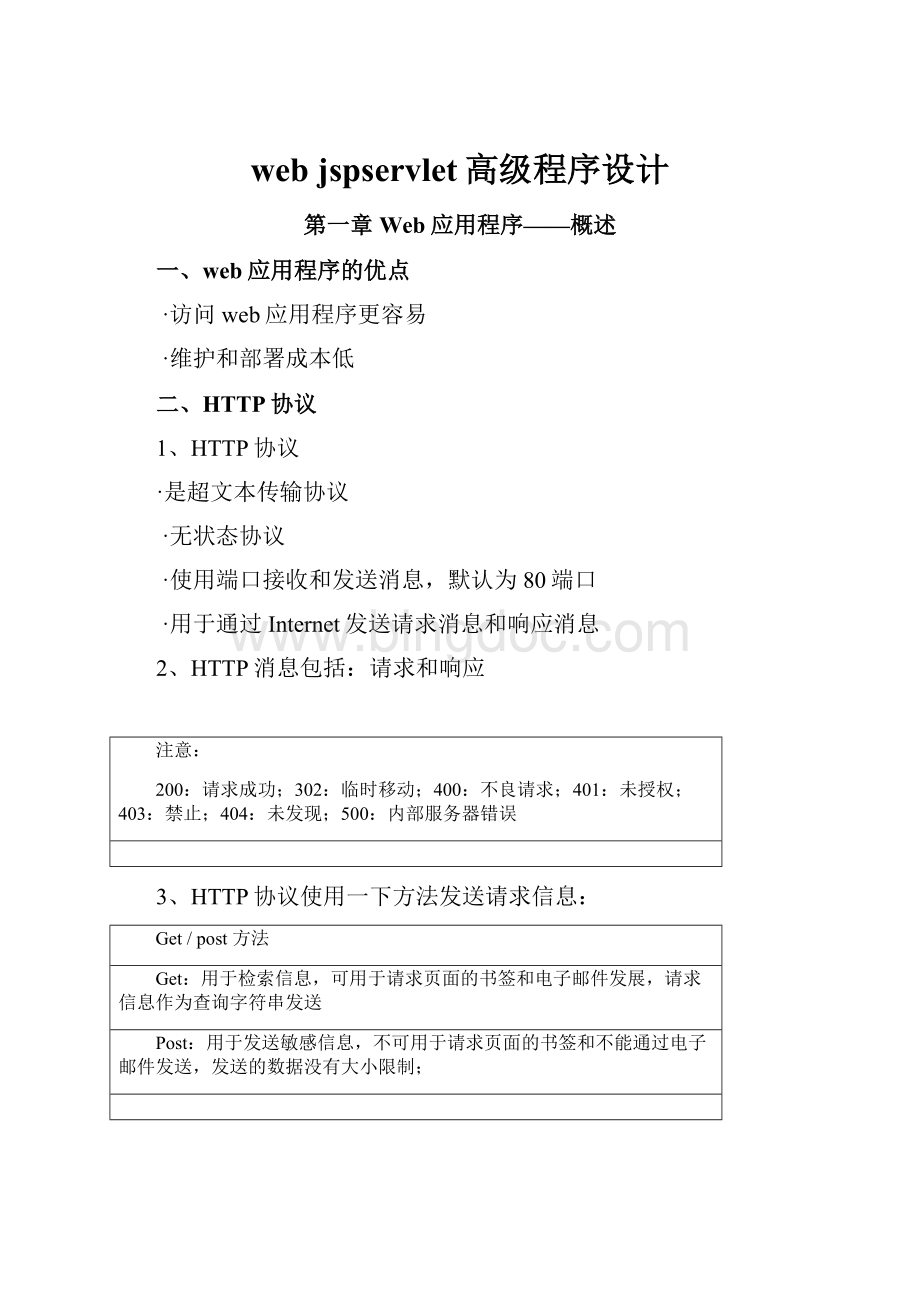web jspservlet高级程序设计Word文档格式.docx
《web jspservlet高级程序设计Word文档格式.docx》由会员分享,可在线阅读,更多相关《web jspservlet高级程序设计Word文档格式.docx(46页珍藏版)》请在冰点文库上搜索。

一、JSP页面元素
1、静态内容:
---------------------------HTML静态文本
2、指令:
-----------------------------以”<
%@开始”,”以%>
结束”
例如:
‘<
%@includefile=’fileman’%>
’
3、表达式:
--------------------<
%=表达式%>
4、scriptlet:
------------------<
%代码%>
5、声明:
---------------------------<
%!
函数%>
6、动作:
-------------------------以‘<
jsp:
动作名’开始;
以‘<
/jsp:
动作名’结束
例如:
<
includepage=’filename’/>
7、注释:
·
!
----------------------这是注释---------------------->
(客户断可以看到的)
%------------------这也是注释--------------------%>
(但客户端不能查看到的)
例子:
指令:
%pagecontentType=’text/html’;
charset=’GBK’;
language=’java’;
import=’java·
util·
calendar’%>
声明:
String.getHello(Stringname){
Return‘Hi’+name+’!
}
%>
Jspscriptlet
%
Calendarnow=calendar.getInstancec()
静态内容
html>
head>
/head>
------------------这是注释,是客户端可以看到的------------------>
%----------------这也是注释,但是客户端看不到的---------------%>
body>
<
h1align="
center"
>
JSP页面构成<
/h1>
%=getHello(‘朋友’)%>
%if(now.get(Calendar.AM_PM)==Calendar.AM){%>
早上好!
%}else{%>
下午好!
%}%>
br>
param.name=’str’value=’参数’/>
include>
/body>
/html>
JSP页面
客户端
二、JSP执行过
请求
编译
ajsp.class
ajsp.java
a.jsp
响应
执行
3
转译
1
2
SERVLET
1、转换和编译
JSP
从JSP元素中提取数据转译判断JSP中的错误
为JSP生成一个SERVLET编译
SERVLET
三、开发过程
1、创建JSP工程-------------------2、创建web模块--------------3、创建JSP------------4、调试运行
例子1:
Doubleradius=60;
PrivatdoublegetRadius(){
Returnradius;
PrivatedoublegetDiameter(){
Return(radius*2);
PrivatedoublegetArea(){
Return(3.1415*(radius*2));
PrivatedoublegetCircumference(){
Return(3.1415*radius*2);
圆半径:
%=radius%>
圆直径:
%=getDiameter()%>
圆面积:
%=getArea()%>
圆周长:
%=getCircumference()%>
例子2:
formaction=’circle_area.jsp’method=’post’>
半径:
inputtype=’text’name=’redius’>
<
inputtype=’submit’value=’提交’>
inputtype=’reset’value=’重置’>
/form>
Circle_area.jsp
DoublecircleArea(doubleredius)
{
Return(math.PI*redius*redius);
Stringredius=request.getparameter(‘redius’)
Doublereduss=Double.parsedouble(redus);
Doublearea=cricleArea(rediuss);
半径:
%=reduss%>
的面积:
%=area%>
资料例子1
资料例子2
资料例子3
第三章JSP脚本和指令的使用
一、JSP脚本元素
JSP脚本元素
表达式scriptlet声明
二、表达式的概念
1、表达式是对数据的表示,系统将其作为一个值进行计算和显示
2、表达式的表现形式:
%=Java表达式%>
b>
PI的值:
/b>
%=math.PI%>
100,99中最大值:
%=math.max(100,99)%>
100,99中最小值:
%=math.min(100,99)%>
3+2-5的值:
%=3+2-5%>
(3+2)==5的值:
%=(3+2)==5%>
(3+2)!
=5的值:
%=(3+2)!
=5%>
三、JSPSCRIPTLET的概念
JSPSCRIPTLET就是在JSP页面里嵌入一段Java代码
JSPSCRIPTLET表现形式:
%Java代码%>
例子:
For(inti=1;
i<
10;
i++){
For(intj=0;
j<
=I;
j++){
Out.print(j)
Out.println(‘<
’)
四、Jsp声明的概念
1、jsp声明的概念
JSP声明就是在JSP页面中声明JAVA方法变量等
JSP声明表现形式:
JAVA代码%>
2、将整数转换成带两为小数
//申明一个常量
FinalStringseparatop=’.’;
//声明一个方法
PublicStringcoverts(Stringmoney){
Intindex=money.indexof(separatop);
Stringstr=money;
If(index==-1){
Str=money+’.00’;
Returnstr;
五、JSP指令
JSP指令
Pageincludetaglib
1、指令语法
%@指令名称属性1=‘属性值’,属性2=‘属性值’属性N=‘属性值N’%>
2、page指令用于设置JSP页面的属性
属性:
languageimportisErrorpageerrorpagebuffer
Language------------------定义要使用的脚本语言
Import--------------------将包和方法导入scriptlet
isErrorpage------------表示当前页面能否作为错误页面
errorpage---------------定义处理异常的JSP页面
buffer--------------------设置用来存储客户端请求的缓冲区的大小
%@
Pagelanguage=’java’import=’java.util*’buffer=’8kb’errorpage=’errorjsp’isErrorpage=’false’
---------------------page指令属性
3、include指令是用于将在运行是将HTML文件或JSP页面嵌入到另一个JSP页面
include语法:
%@includefile=’文件名’%>
例子:
%@includefile=’/test.html’%>
还可以放在html上面
4、taglib指令可以让jsp页面使用标签
语法:
%@tagliburi=’标签库表述符文件’prefix=‘前缀名’%>
%@tagliburi=’/mytaglib.tld’prefix=’mytags’%>
六、例子
例子1:
将整数转换成两为小数
Stringformats(doubleb){
Nummberformatnf=numberformat.getinstance();
Nf.setMaxmumfractimwigits
(2);
Nf.setMinimumfractionwigits
(2);
Returnnf.format(b)
%=formats(6)%>
例子2:
//格式化日期的输出
StringformatDAte(dated){
//yy年MM月dd日hh时mm分ss秒
simpleDateformatsdf=newsimpleDateformat(yy年MM月dd日hh时mm分ss秒);
StringdateString=sdf.format(b)
Returndatestring;
%=formatDate(newdate())%>
第四章JSP隐式对象
一、JSP隐式对象的定义
1、定义:
jsp隐式对象是web容器加载的一组类,它不用‘new’去获取实例,而是可以直接在jsp页面使用的对象
隐式对象
输入\出对象作用域通信对象servlet对象错误对象
Requestsessionpage
Resporseappticationexception
Outpagecontextconfig
二、request对象常用方法
Stringgetparameter(Stringname)
根据表单组件名称获取请求页面提交数据
Stringgetparametervalues(Stringname)
获取页面请求中一个表单组件对应多个值是的用户的请求数据
Stringname=request.getparameter(‘name’)
Stringchannels=request.getparametervalues(“channel”)
三、response对象常用方法
voidsetcontentType(Stringname)
设置作为响应生成的内容的类型和字符编码
voidsendredirect(Stringname)
发送一个响应给浏览器,指示起应请求另一个URL
Response.setcontentType(‘text/html,charse=GBK’);
Response.sendredirect(‘response.jsp’);
四、out对象
javax.servLet.jsp.writer类型的实例
使用write(),print()和println()方法
Out.print(“欢迎来到jsp;
隐式对象”);
五、作用域通信对象
隐式对象的作用域包括page、request、session、和application
作用于通信对象包括:
session、application和pagecontext
六、session对象
web服务器为单个用户发送的多个请求创建的会话
作用:
存储有关用户会话的所有信息
javax、servlet、http、httpsession接口的实例
session对象最常用的方法
1、·
voidsetAttribute(Stringname,objectvalue)
以键/值的方式,将一个对象的值存放到session中
2、·
voidgetAttribute(Stringname)
根据名称去获取session中存放对象的值
Session.setAttribute(‘name’,’admin’)
If(session.getAttribute(name)!
=null){
Stringname=(String)session.getAttribute(‘name’);
七、application它与session同理
javax.servLet.servLetcontext接口实例
%application.setAttribute(‘chartrecord’,’hihi’)%>
%if(application.getAttribute(‘chartrecord’)!
Stringchartrecord=(String)application.getAttribute(‘chartrecord’)
八、pagecontext同上
九、servlet对象
1、jsp引擎为每个jsp生成一个servlet
servlet对象提供了访问servlet信息的方法和变量
servlet对象包括:
page和config
十、page对象
使用page对象可以访问servlet类的所有变量和方法
十一、config对象
提供了检索servlet初始化参数方法
十二、Exception对象
Exception对象:
1用于处理jsp页面中的错误;
2用于访问执行jsp的过程中引发的异常
3是java.lang.throwable类的实例
十三、例子
%@pageisErrorpage=’true’%>
h1>
隐式对象异常<
以检测到以下错误<
%=exception%>
%exception.rintstackTrance(out)%>
例子2:
处理错误
If(exception!
Out.write(“\n发生错误\n”);
}else{
Out.write(“\n你已访问此页面,但是没有可用的错误信息\n”)
第五章javaBean和jsp的标准动作
一、javaBean的优点
1、javaBean的优点
可重用组件
可在多个应用程序中使用
可以跨平台
2、用途
将javaBean嵌入jsp页面
设置和获取javaBean的属性
将用户请求转发给其他页面
将其它页面的内容嵌入当前页面
useBeanid=’BeanID’class=’MyBean’scope=’page’>
二、UseBean动作范围指定javaBean在jsp页面中的可用性范围
PageBean
只能在使用页面是使用,当加载新页面时,将其销毁
RequestBean
在用户对其发出请求的存在
SessionBean
一直存在于会话中,知道其终止或被删除为止
Applicationbean
在整个应用程序中均可使用
Get()方法和set()方法用于访问javaBean的属性
Get()方法javaBean的属性set()方法
定义公有方法get()方法返回值
定义公有方法set方法给属性赋值
Importjava.io.*;
PublicclassMyBean{
PrivateStringname;
PublicMyBean(){}
PublicStringgetName(){
Returnname;
PublicvoidsetName(StringMyName){
This.name=MyName;
三、jsp的标准动作
1、jsp的标准动作
useBean>
<
getproperty>
setproperty>
forward>
2、setproperty动作
useBeanid=’BeanID’class=’MyBean’scope=’session’/>
setpropertyname=’BeanID’property=’name’value=’示例’/>
getpropertyname=’BeanID’property=’name’/>
3、示例:
在jsp中使用javaBean
useBeanid=’BeanId’class=’example5.sinpleseem’scope=’application’/>
setpropertyname=’BeanId’property=’age’value=’25’/>
姓名:
getpropertyname=’BeanId’propery=’name’/>
年龄:
getpropertyname=’BeanId’property=’age’/>
//<
jsp;
forwardpage=’second.jsp’/>
四、include动作
<
includepage=’otherPage.jsp’flush=’true’/>
五、例子
第六章jsp表达是语言
一、EL为表达式语言
1、EL用于以下情况
静态文体
标准标签和自定义标签
table>
tr>
td>
逻辑运算<
/td>
EL表达式<
Result<
/tr>
与<
${‘${’}trueandtrue<
${trueandtrue}<
${‘${’}true&
&
false}<
${true&
&
false}<
或<
${‘${’}trueorfalse}<
${trueorfalse}<
${‘${’}true||false}<
${true||false}<
非<
${‘${’}nottrue}<
${nottrue}<
${‘${’}!
${!
/table>
inputtype=’text’name=’num’value=’${param[‘num’]}’>
例子3:
pageContext.setAttribute(‘color’,’#FFFFCC’)
bodybgcolor=’${pageScope.color}’>
变化的背景色,<
二、禁止EL计算的语法为
1、禁止EL计算的语法为:
%@pageisElIgnored=’false/true’%>
%@pageisELIgnored=false/true%>
false/true